Products You May Like
Hellroaring Basin scallops into the westward flank of Whitefish Mountain Resort as though the forces of nature which conspired to create it understood the joys of expert skiing, and were in a generous mood at the moment of creation. The three skiers tipping off Hellroaring’s rim into the basin’s steep trees to loft through billows of fresh, untracked Rocky Mountain powder know all about it. Together the trio—a realtor, a ski patroller, and a literary journal editor—have called Whitefish home for a combined 125 years.
They know the white pines and Douglas fir through which they weave and the lines that deliver extra thrills on this steep pitch. They know that the grizzlies who reclaim Hellroaring Basin as their own every April will soon be stirring with the first signs of spring.
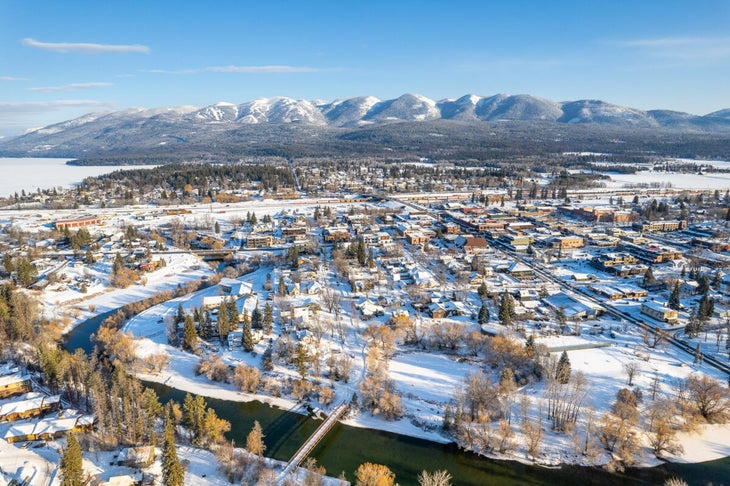
They know the contours of Glacier National Park’s spires, the sunlight that plays across the expansive Flathead Valley, the fog that rolls in to obscure it all, and the stars that glimmer in Montana’s dark night sky when the fog clears—and they know these things just as well as they know the names of the lifties who load the chairlifts, the staffers at Nelson’s Hardware, and everyone else’s kids.
They know they live in a place where community is valued more than amenities, but where the topography—including a mountain with the same amount of ski terrain as Breckenridge but a quarter of the skiers, a Wild West downtown, and a magnificent national park—delivers a rarefied mix. It’s a place where life is good, and they know it.
Related: The top 10 resorts in the West for terrain variety
Most of all, however, they know that everything they most cherish about Whitefish is at risk.
While the ski experience here is on the rise—Whitefish Mountain Resort’s independent ownership group is in the midst of a multimillion dollar capital improvement plan (see sidebar, page 92) that defies current industry trends in its strategy—Whitefish otherwise is in the crosshairs of a crisis.
Many who work in Whitefish can no longer live in Whitefish. Housing for those who derive their income from Whitefish-based jobs is in short supply, by about 1,000 residences. What is available is sky high: Real estate prices have jumped as much as 82 percent since early 2020; in some instances they have more than doubled. Incomes earned within the region’s outdoor tourism-centered seasonal economy cannot keep pace. As a result, employers can’t get or keep employees, particularly during peak season (which is actually summer, due to the proximity of Glacier National Park). Many businesses now must shutter several days per week because of lack of staff.
The surge in non-residents acquiring properties and turning them into short-term rentals a la Airbnb and VRBO has been overwhelming: In 2013, there were 15. Today, in the city of Whitefish alone, there are 487. In the greater Whitefish area there are a total of 1,271. Many of those properties directly result in decreased housing for locals and increased beds for visitors, further straining the housing and workforce equation, the visitor experience, and the quality and sustainability of Whitefish’s distinctive brand of life. There’s bad traffic and bad behavior—human waste being left where it shouldn’t be, for example—a loss of civility, and a ramped-up pace. Existing infrastructure is maxed out.
Related: Did the pandemic finally put an end the modern-day ski bum?
“The only thing we thought was saving us all these years was the fog,” says the powder-skiing realtor, Mike Muldown, 77, whose father, Lloyd, was a pivotal Whitefish ski pioneer. “Now Whitefish life is pretty much gone.”
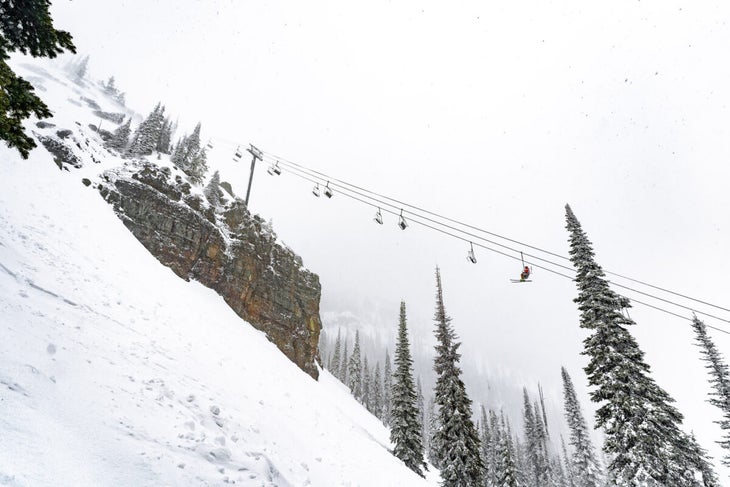
Whitefish is not alone. The pandemic’s sudden increase in demand for open spaces and wild places and the concomitant rise in remote work slammed head-first into a slow-moving but highly charged mass of intertwined disturbances that had been building for decades. These include the rise in real estate as a wealth creation and wealth management vehicle rather than as primary housing; the growth of the short-term rental industry; the increasing stratification of premium ski experiences in alignment with financial privilege; and much more. Across the mountain west the resulting tempest is changing the character and livability of ski towns—including Park City, Truckee, and Crested Butte—in ways abrupt and dramatic.
Related: The top 10 resorts in the West with the best local flavor
At the eye of the storm: Are mountain towns communities or commodities? What role is there for local self-determination and intentional stewardship? Who gets to live the proverbial dream, or even access it? What does that dream look like, and who gets to decide?
•••
Whitefish was facing these same questions from a very different perspective when Rhonda Fitzgerald arrived in 1977. She and her husband, Mike, had just moved from Aspen to Whitefish with their young family. It was a leaner time for Whitefish, with railroad and timber work in decline. “There were no jobs,” Fitzgerald remembers. “You had to make your own.”
The couple opened a little ski shop. They raised their kids, got to know their neighbors, skied, hiked, played on the lake, and settled into Whitefish life. Ten years later, Fitzgerald—who by then was also a professional chef—opened the Garden Wall Inn, a five-room hotel.
The economy in Whitefish got tougher. The timber industry dwindled and nearly took the town with it. But community-based businesses—from the locally owned bank to the ski hill to the grocer—chipped in, buoyed their neighbors, and got each other through it.
In the ’90s, Fitzgerald rallied with other businesspeople to spearhead a visitors’ bureau, known today as Explore Whitefish. The mandate: Spread the word about this easygoing, community-focused, edge-of-the-wilds, lakeside ski town and in the process help even out the economic highs and lows for year-round working locals.
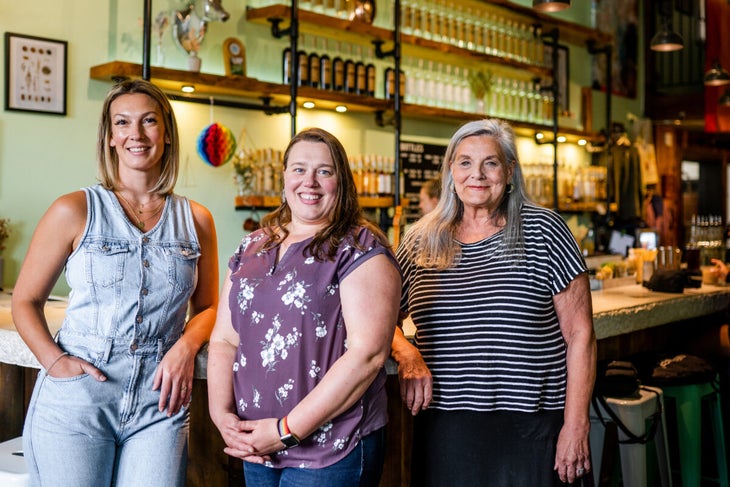
Since then Fitzgerald, now 71, has become, in many ways, the mama bear of Whitefish, defending issues at the intersection of community life and economic vitality, championing Montana’s unhurried and place-based style of living, and fighting to ensure that the people of Whitefish both survive and thrive. Today she sits on Montana’s Tourism Advisory Council (a governor-appointed
position she has held since 2005), chairs that council’s research arm, and participates in seemingly every volunteer Whitefish committee, including those tackling downtown revitalization and affordable housing.
The triple bottom line model of sustainable tourism lies at the root of it all. It’s a vision in which communities and their surrounding environs are not negatively affected by visitorship but instead enhanced by it. The overarching idea, says the official Montana Tourism Charter that Fitzgerald helped craft, is to “maintain a destination’s sense of place and complement rather than compete with the needs of local residents.” Even in ski towns.
But current trends—namely spikes in upscale real estate development and out-of-town buyers displacing Whitefish locals—have Fitzgerald concerned.
“It’s almost an extractive industry,” Fitzgerald says. “Like coal or copper mining. They’re mining the value that everyone else builds, pulling it out for their own purposes and removing that value from the community. I don’t think they mean to destroy the very thing that brought them here, but they’re not reinvesting in the community. That’s the flaw. They’re short-term. A real business reinvests in its physical plant, and our physical plant is our community.”
•••
What is now Whitefish was long the domain of indigenous peoples—Ktunaxa, Kootenai, Pend d’Oreille, and Bitterroot Salish—towering forests, and profuse wildlife. In the late 1800s it became a timber town, which by the early 1900s became a railroad town, with saloons, general stores, banks, and churches arrayed in a prototypical frontier grid. It was a rugged place, carved into the edge of the wilds, where winters were hard, community bonds were strong, and Whitefish Lake made summers sweet.
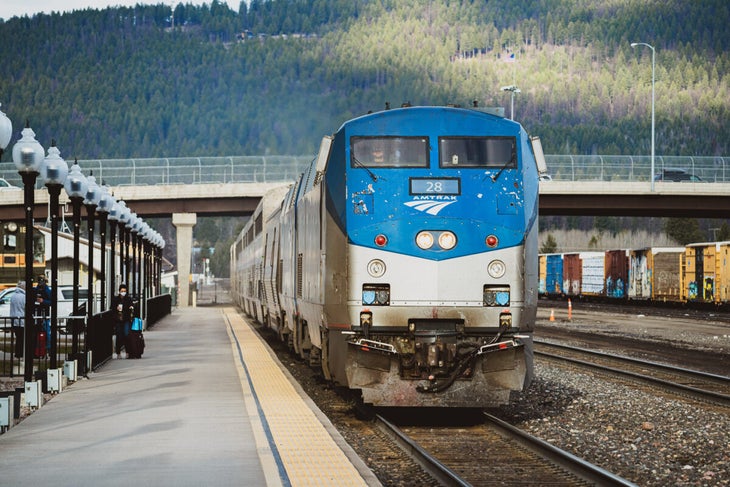
In the early 1930s, a few ardent locals—notably Mike Muldown’s father Lloyd “Mully” Muldown—began climbing up the big mountain north of town to ski it. Soon there was a club with cabins, and a thriving uphilling and downhilling scene. In December 1947, funded largely by shares sold to Chamber of Commerce members, the ski area and its first lift, a T-bar, officially opened for business. Known for its first 60 years as The Big Mountain, it had its glamorous eras and its near-bankrupt ones, but the community kept buying shares, and soon Whitefish became a ski town, too.
Until relatively recently it was still the kind of place where a recent college grad could rattle up US 93 in a beat-up pickup, find an affordable room in a house with two roommates, land a day job with the
Forest Service and a night job as a short-order cook, and stay a while. Like a lifetime. That’s exactly what Whitefish mayor John Muhlfeld did in 1995.
“My first winter here, I remember just flailing my way down the face of Big Mountain wondering what the hell I was doing, but then I became a very avid skier and the mountains drew me in,” says Muhlfeld, now 49.
A hydrologist, Muhlfeld worked for various government agencies before co-founding a firm that consults on waterway restoration projects throughout the Pacific Northwest. In 2006, he was elected to city council and served for six years. In 2012, he was elected mayor, a position he has held for three consecutive terms to date. It is an unpaid job, and a demanding one, particularly now.
“People are very concerned,” Muhlfeld says. “They’re seeing rapid change. It’s quite scary to them, especially those who have lived and worked here forever, to see this happen in just two years.”
The core of the matter is what Muhlfeld calls “the affordability gap.” In 1995, Muhlfeld paid $150 per month for a private bedroom in a shared downtown Whitefish house. Four years later, while earning $12.50 per hour as a professional hydrologist at the Montana Department of Natural Resources and Conservation, he cobbled together enough money to buy a two-bedroom, one-bath bungalow in the heart of town. The cost: $68,000.
“That same home would probably sell tomorrow for about $800,000,” Muhlfeld says. “And certainly wages haven’t increased commensurate with the cost of housing. So there’s no way that an individual today who holds the position I had back in 1999 could afford to live and raise a family in Whitefish.”
Workers in entry-level, front-line, and low-paying jobs—roles essential to tourism-centered mountain town economies—are not the only ones being impacted, explains distiller and entrepreneur Lauren Oscilowski, 38, who chaired the city’s Sustainable Tourism Management Plan Committee for three years.
“People hear affordable housing and they think line cooks, dishwashers, waitresses, bartenders. But nurses that work at the hospital can’t afford to live in Whitefish because the home they were renting gets sold and the new owners increase the rent 40 percent or decide they’re going to go short-term, and then the nurses can’t find housing,” Oscilowski explains. “So we’re not just talking about front-of-house workers. We’re talking about teachers, police, firefighters. We’re talking about city staff. We’re talking about salaried managerial positions and skilled workers. It’s staffing for everything.”
Muhlfeld concurs, citing multiple Whitefish professionals in career positions paying $73,000 to $113,000 per year plus benefits. “They still can’t afford to live here.”
Housing’s affordability and availability both for seasonal workers and for full-time residents at all life and career stages are not new issues for mountain towns, particularly high-cost resort destinations. Both Aspen and Whistler, for example, first launched resident-restricted housing programs in the early 1980s, and have continued to evolve those programs ever since.
And for good reason: In ski towns, a sufficient supply of quality housing that is affordable (generally defined as no more than 30 percent of a household’s total income before taxes) is both a values-based social issue as well as an economic and sustainability one.
This is because tourism throughout the mountain west is not accidental. In many places, it has been fostered as an economic engine intended to supplement or replace once-robust extractive industries like mining and logging. In Flathead County, in which Whitefish is located, tourism and related industries currently account for more than $600 million in economic activity annually.
This engine accelerated at a slow and steady pace up to around 2015. Until then, Whitefish was a place where a person whose primary objective was to live their life in close proximity to mountains, rivers, and wild spaces could make it happen on earnings garnered working in those very places, whether as a hydrologist, craft distiller, or ski patroller. But between 2013 and 2017, Glacier Park visits increased by more than 1 million annually and Whitefish Mountain Resort skier visits bumped from the 200,000s to the high 300,000s.
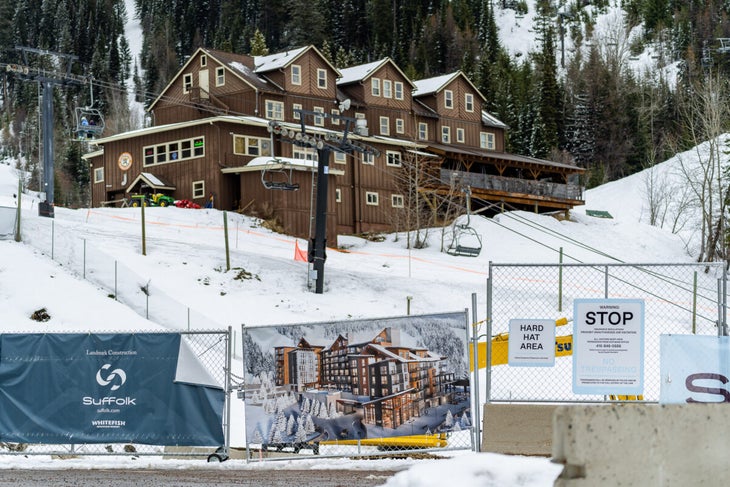
The town felt the pressure, not only on housing and staffing but also on infrastructure, traffic, and local character. In response, the community launched comprehensive initiatives focused on both workforce housing and sustainable tourism management. The resulting plans, adopted by the city in 2017 and 2020 respectively, offered detailed road maps that tapped into every viable tool. First up: Address the immediate deficit of 730 to 980 affordable housing units needed by 2020 to both catch up and keep up.
However, since 2017, only about 120 new deed-restricted housing units have been built in Whitefish. Yet there’s been no shortage of other construction: Developers cannot build contemporary mountain properties fast enough for all the people who want to buy them—at prices starting at $800,000 for around 1,000 square feet of living space, or more than 300 percent greater than what’s considered affordable for Whitefish’s typical median annual household income of $50,000 to $60,000.
In part, says Muhlfeld, the city’s ability to address attainable housing has been hobbled by the state. A key component of Whitefish’s Strategic Housing Plan was a regulatory tool called mandatory inclusionary zoning, which required 20 percent of all units in new residential developments to be deed-restricted and keyed to specific percentages of Area Median Income. But Montana is a place where property rights are king. In 2021, Montana’s state legislature passed a bill that prohibits local governments from implementing any regulations for, in the words of the bill, “the purposes of providing housing for specified income levels.”
Meanwhile, the housing shortage grew dramatically more acute, as did the affordability gap.
“The curve has steepened considerably since the pandemic,” Muhlfeld says. And what was unleashed by the pandemic may or may not be possible for the people of Whitefish to rein in.
•••
For ski towns everywhere, the pandemic magnified challenging trends already on the rise. In Whitefish, the effect was exponential: The outdoors beckoned. Montana seemed safe. Working remotely became normalized. People surged into Whitefish. Reservations weren’t required for skiing or parking, and tickets weren’t expensive. Lift lines—while long for Whitefish—weren’t trending on social media feeds. Skier visits jumped above 450,000 per season.
But something else happened, too.
Homes in modest neighborhoods historically occupied by full-time residents working and raising their families in Whitefish began getting snapped up as soon as they were listed—often well over asking price, sight unseen and for cash—by people from outside the community. Many of these new owners put them on short-term rental (STR) platforms like Airbnb and VRBO, sometimes renting to local workers for only six or nine months at a time then shifting back to STR during peak seasons.
One out-of-state resident who preferred to speak off the record boasted that she grosses eight to nine times as much annually renting her Montana property on Airbnb as she garners from full-time renters.
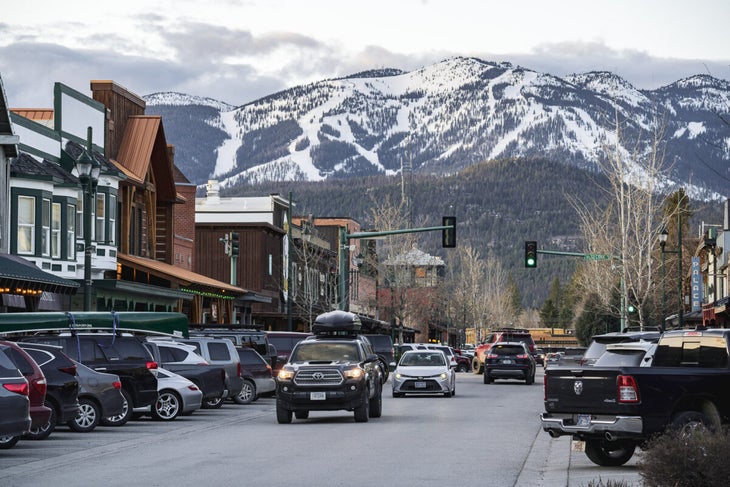
For the Whitefish community, the math is quite different.
“People who care about and are invested in our community are replaced by people who are invested on our community,” says Oscilowski. “Every time one of those houses turns into a short-term rental, we lose the housing for the workforce and we gain tourists. It’s a problem, and it’s not going to be solved just by building affordable housing. We also have to regulate short-term rentals.”
She has a solid perspective from which to sound the alarm. In 2015, at the age of 31, Oscilowski rolled up her sleeves, assembled a Portuguese still, made mash from Montana sugar beets, and opened a distillery and tasting room across from the Whitefish train depot. Today Spotted Bear Spirits is sold in liquor stores throughout Montana, and the tasting room’s cocktails regularly win awards. In the process, Oscilowski has created 16 jobs and a signature hospitality experience in downtown Whitefish.
But both she and her staff have been grappling with finding stable, affordable places to live. The distillery’s sales manager, Brant Giovannetti, 37, spent two years looking for housing to buy, but also for stable housing to rent after a previous living arrangement soured.
“I pretty much gave up on Whitefish,” Giovannetti says. “I’m renting from friends now in Columbia Falls,” 10 miles away. “The only reason I got in there was because I knew them.”
While Giovannetti found a way to stay on, others have moved away, and replacements are hard to find. “It’s hard to sit by and see your staff have to move three times in one year,” says Oscilowski. “That impacts the quality of life for your staff, it impacts the company morale, and it impacts our bottom line.”
•••
There’s no shortage of morale on the big mountain north of town, where uphilling remains a thriving local scene. Whitefish Mountain Resort’s dedicated uptrack streams with uber-fit regulars. Cascading downhill past the climbers on the broad, groomed boulevards that seem to spill into Whitefish Lake are every type of skier and snowboarder: Someone goes by dressed as a banana. A hefty guy with a cigar pauses every few turns to catch his balance and take in the view. Families cruise. At the summit, skiers spilling off Big Mountain Express gather in front of the trail map board, deciding which way to go on this near-360 degree ski hill. A group of women with southern twangs and shiny baubles on their belted ski suits pose for a photo in front of the big view of the “Crown of the Continent,” the peaks of Glacier National Park.
All of this points to what makes Whitefish so special, more so than the skiing and the lake, the wild spaces, the national park, or the historic downtown. The true commodity is not real estate or a mountain lifestyle for a few weeks a year or even a powder run in Hellroaring Basin. The invaluable, ineffable, inestimable Whitefish commodity is the community itself.
On the deck of the Summit House, a bride and groom in formalwear are just finishing their vows. Onlookers cheer and applaud. A few steps away, college-age guys wearing Hawaiian shirts over ski clothes tip their heads back and drink what looks like red wine out of a gallon-sized Ziploc. Someone poles past dressed as a rainbow unicorn, and no one bats an eye.
There’s no fog today, and none of the bitter cold that locals keep talking about in hopes of keeping newcomers away. The glide down Inspiration back to the base is as good as groomed boulevard skiing gets: Broad and rolling, with pitches that thrill and views that don’t stop. Sunlight plays across the expansive Flathead Valley, illuminating the Wild West town laid out in a grid and its lovely, crystalline lake.
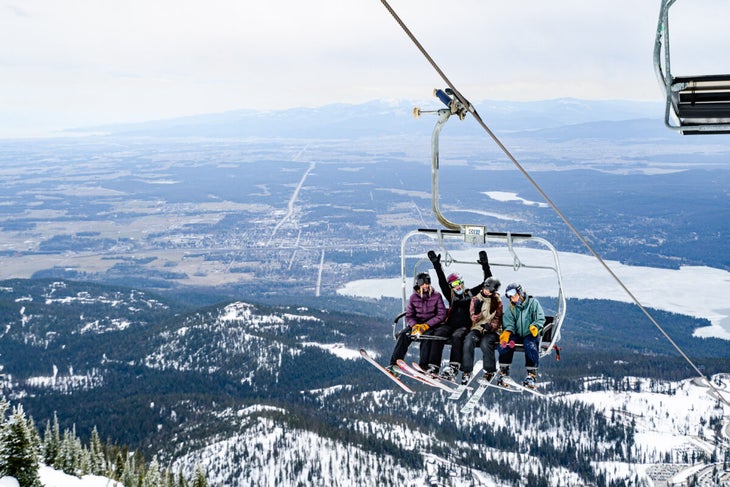
Back on the valley floor, over a Spotted Bear Spirits Salt and Pepper cocktail, Oscilowski shares some news. She and her husband haven’t been able to find a home in Whitefish, but they met an elderly resident in the nearby town of Columbia Falls who wanted to sell his house to a young couple who would raise a family and be part of the community, just as he had done. They bought it in a private sale. The distillery and tasting room will stay in Whitefish, but as a non-resident she can no longer chair the sustainable tourism committee. When the dust settles, she says, she’ll invest her volunteer efforts into supporting Columbia Falls.
The irony is not lost. Perhaps Whitefish isn’t either, though only time will tell.
Rhonda Fitzgerald, for one, is optimistic. The Whitefish community is “galvanized,” she says. “I think in the next 10 years we’re going to see more than a thousand deed-restricted units. In order to work and live in Whitefish, you’ll have to live in deed-restricted housing, but it will still be possible to have a really great ski town life. I think we can do it.”
More from SKI’s 2023 Destination Guide
Why dragging your kid on a ski trip is (almost) always a good idea
Discover this newly revived Down East resort before everyone else does
